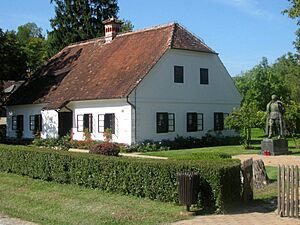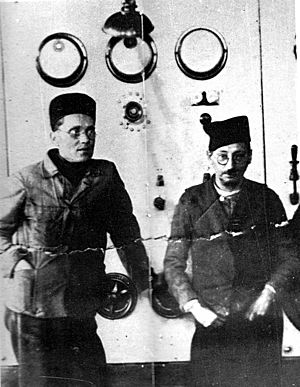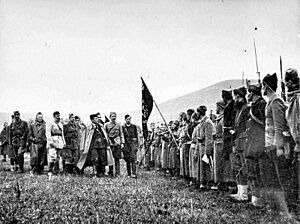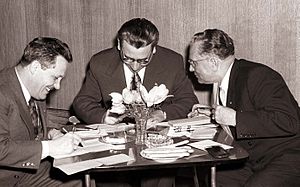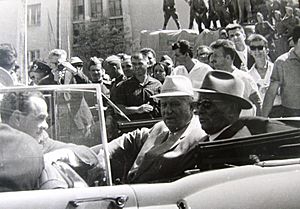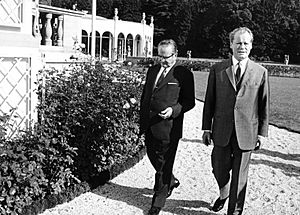Josip Broz Tito facts for kids
Quick facts for kids
Marshal
Josip Broz Tito
|
|||||||||||||
|---|---|---|---|---|---|---|---|---|---|---|---|---|---|
| Јосип Броз Тито | |||||||||||||
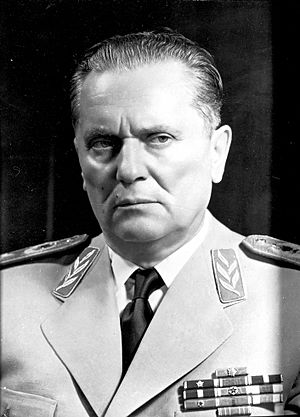
Portrait of Tito from 1961
|
|||||||||||||
| President of Yugoslavia | |||||||||||||
| In office 14 January 1953 – 4 May 1980 |
|||||||||||||
| Prime Minister |
See list
Himself (1953–1963)
Petar Stambolić (1963–1967) Mika Špiljak (1967–1969) Mitja Ribičič (1969–1971) Džemal Bijedić (1971–1977) Veselin Đuranović (1977–1980) |
||||||||||||
| Vice President |
See list
Aleksandar Ranković (1963–1966)
Koča Popović (1966–1967) Krste Crvenkovski (1971–1972) Ratomir Dugonjić (1972–1973) Mitja Ribičič (1973–1974) Petar Stambolić (1974–1975) Vladimir Bakarić (1975–1976) Vidoje Žarković (1976–1977) Stevan Doronjski (1977–1978) Fadil Hoxha (1978–1979) Lazar Koliševski (1979–1980) |
||||||||||||
| Preceded by | Ivan Ribar (as President of the Presidency of the People's Assembly) |
||||||||||||
| Succeeded by | Lazar Koliševski (as President of the presidency) |
||||||||||||
| 19th Prime Minister of Yugoslavia | |||||||||||||
| In office 2 November 1944 – 29 June 1963 |
|||||||||||||
| President | Ivan Ribar Himself (from 1953) |
||||||||||||
| Preceded by | Ivan Šubašić | ||||||||||||
| Succeeded by | Petar Stambolić | ||||||||||||
|
|||||||||||||
| 1st Secretary-General of the Non-Aligned Movement | |||||||||||||
| In office 1 September 1961 – 5 October 1964 |
|||||||||||||
| Preceded by | Office established | ||||||||||||
| Succeeded by | Gamal Abdel Nasser | ||||||||||||
| 4th President of the League of Communists of Yugoslavia | |||||||||||||
| In office 5 January 1939 – 4 May 1980 |
|||||||||||||
| Preceded by | Milan Gorkić | ||||||||||||
| Succeeded by | Stevan Doronjski | ||||||||||||
| Personal details | |||||||||||||
| Born |
Josip Broz
7 May 1892 Kumrovec, Kingdom of Croatia-Slavonia, Austria-Hungary (now Croatia) |
||||||||||||
| Died | 4 May 1980 (aged 87) Ljubljana, SR Slovenia, SFR Yugoslavia (now Slovenia) |
||||||||||||
| Resting place | House of Flowers 44°47′12″N 20°27′06″E / 44.78667°N 20.45167°E |
||||||||||||
| Nationality | Yugoslav | ||||||||||||
| Political party | League of Communists of Yugoslavia | ||||||||||||
| Spouses |
|
||||||||||||
| Domestic partners | Davorjanka Paunović (1943–1946) |
||||||||||||
| Children | 4, including Mišo | ||||||||||||
| Awards | 98 international and 21 Yugoslav decorations | ||||||||||||
| Signature |  |
||||||||||||
| Military service | |||||||||||||
| Allegiance |
|
||||||||||||
| Branch/service | Austro-Hungarian Army Red Army Yugoslav People's Army |
||||||||||||
| Years of service | 1913–1915 1918–1920 1941–1980 |
||||||||||||
| Rank | Marshal | ||||||||||||
| Commands | National Liberation Army Yugoslav People's Army (supreme commander) |
||||||||||||
| Battles/wars | World War I Russian Civil War World War II |
||||||||||||
Josip Broz (born May 7, 1892 – died May 4, 1980), known as Tito, was a very important leader in Yugoslavia. He was a communist revolutionary and politician. He led Yugoslavia from 1943 until he died in 1980. During World War II, he was the leader of the Yugoslav Partisans. This group was seen as one of the best resistance movements in Europe that was occupied by Germany. He also served as the president of the Socialist Federal Republic of Yugoslavia from 1953 until his death.
Tito was born in Kumrovec, a village that is now in Croatia. His father was Croat and his mother was Slovene. He joined the military and became a very young sergeant major. During World War I, he was captured by the Russians. He later took part in some events of the Russian Revolution in 1917. When he returned home, he joined the Communist Party of Yugoslavia. He became the leader of this party in 1939.
After World War II, Tito helped create the Socialist Federal Republic of Yugoslavia. He was the prime minister and later the president. He was also the marshal of Yugoslavia, which was the highest military rank. Tito was one of the first leaders to stand up to the Soviet Union in 1948. He created Yugoslavia's own socialist system. This system allowed workers to manage their own businesses.
Tito was very popular both in Yugoslavia and around the world. He helped keep different ethnic groups in Yugoslavia living together peacefully. He also became a main leader of the Non-Aligned Movement. This group included countries that did not want to side with either the United States or the Soviet Union during the Cold War. After he died, Yugoslavia broke apart and had several wars.
| Top - 0-9 A B C D E F G H I J K L M N O P Q R S T U V W X Y Z |
Early Life and Adventures
Growing Up in Croatia
Josip Broz was born on May 7, 1892, in Kumrovec, a village in what is now Croatia. At that time, it was part of the Austro-Hungarian Empire. He was one of many children born to Franjo Broz and Marija Javeršek. Josip was raised as a Roman Catholic. His father was Croat and his mother was Slovene.
When he was young, Josip spent time with his grandparents. He learned to speak Slovene better than Croatian. He also learned to play the piano. At age eight, he started primary school. He finished four years of school in 1905.
After school, he worked on his family's farm. In 1907, his father wanted him to move to the United States. But they could not find enough money for the trip.
Learning a Trade
At 15, Josip left Kumrovec. He traveled to Sisak to find work. He first worked in a restaurant but soon got tired of it. He then became an apprentice to a Czech locksmith named Nikola Karas. This apprenticeship lasted three years. It included training, food, and a place to live.
During this time, he learned about May Day. He also read and sold a socialist newspaper. After finishing his apprenticeship in 1910, he moved to Zagreb. He joined the Metal Workers' Union. He also took part in his first labor protest. He joined the Social Democratic Party of Croatia and Slavonia.
Josip then traveled a lot to find work. He worked in Ljubljana, Trieste, and Kamnik. He even worked in a factory in Bohemia. He joined strikes to help workers get fair pay. He also worked at the Škoda Works in Plzeň. Later, he worked at the Benz car factory in Mannheim. By 1912, he was in Vienna. He worked at Austro-Daimler, where he often drove and tested cars. During these years, he learned German and some Czech.
World War I Experience
Military Service and Capture
In May 1913, Josip Broz was called to serve in the Austro-Hungarian Army. He joined the 25th Croatian Home Guard Regiment in Zagreb. He went to a school for non-commissioned officers (NCOs) in Budapest. He was then promoted to sergeant major. At 22, he was the youngest in his regiment to hold this rank. He was also a skilled fencer.
When World War I started in 1914, his regiment went to the Serbian border. Josip was arrested for saying things against the empire. After being cleared, his regiment moved to the Eastern Front in 1915. They fought against Russia. Josip was a brave soldier. He once led a small group to capture 80 Russian soldiers.
On March 25, 1915, he was wounded and captured by Russian forces. He became a prisoner of war (POW). He was sent to a hospital near Kazan. He stayed there for 13 months. During this time, he learned Russian by reading books.
Life as a Prisoner and Revolution
In mid-1916, he was moved to a POW camp near Samara Governorate. He used his skills to fix a grain mill. Later, he was sent to a camp near Perm. Here, POWs worked on the Trans-Siberian Railway. Josip was put in charge of all the POWs. He complained when camp staff stole packages meant for prisoners. He was beaten and put in prison for this.
During the February Revolution in 1917, he was freed from prison. He met a Bolshevik who told him about Petrograd. In June 1917, Josip left the unguarded POW camp. He traveled to Petrograd. He joined the July Days demonstrations and saw government troops fire on people. He tried to escape to Finland but was arrested. He was held in the Peter and Paul Fortress for three weeks.
He escaped again and traveled to Omsk in Siberia. This was a 2,000-mile journey. In Omsk, he joined an International Red Guard. This group guarded the Trans-Siberian Railway. In May 1918, anti-Bolshevik forces took control of Omsk. Josip went into hiding. He met Pelagija "Polka" Belousova, a 14-year-old girl who helped him escape. He worked at a mill until November 1919. The Red Army then recaptured Omsk.
In January 1920, Josip married Polka. He was 27, and she was 15. In the autumn of 1920, they returned to his homeland. It was then called the Kingdom of Serbs, Croats and Slovenes.
Becoming a Communist Leader
Early Communist Activities
When Josip Broz returned home, he joined the Communist Party of Yugoslavia (CPY). The CPY was becoming very popular. But the government saw it as a threat. In 1920, the government made communist activities illegal. Josip lost his job because of his communist ties.
He and his wife moved to Veliko Trojstvo. He worked as a mill mechanic. He secretly worked for the CPY, giving out leaflets and talking to factory workers. He believed in strong action, not just moderate policies. In 1924, he was elected to a CPY committee. He was arrested after giving a speech at a funeral. He was charged with causing a public disturbance but was found innocent.
His home was searched often. His wife, Pelagija, had lost several babies. In 1924, their son Žarko was born and survived. In 1925, Josip's employer died. The new owner told him to stop his communist work or lose his job. Josip chose to become a full-time revolutionary.
Rising in the Party
In 1925, Josip moved to Kraljevica on the Adriatic coast. He worked at a shipyard to help the CPY. He loved the Adriatic coast. He helped build up the trade union in the shipyards. He led a strike and was fired. He then worked at a railway factory near Belgrade. He wrote an article about workers being treated unfairly. He was fired again.
The CPY saw his potential. He became the secretary of the Metal Workers' Union in Zagreb. In July 1927, he was arrested again. He went on a hunger strike until his trial. He was found guilty of being a CPY member and sentenced to four months in prison. He went into hiding instead of serving his sentence. He used fake papers and worked undercover to organize other CPY members.
In 1928, Josip attended a CPY conference. He spoke out against different groups within the party. He was elected secretary of the new central committee for the Croatian branch. He was arrested again during a May Day protest. This time, he was identified and charged. He was sentenced to five years in prison.
Time in Prison and New Name
In prison, Josip worked on the electrical system. He chose Moša Pijade, another communist prisoner, as his assistant. Pijade became Josip's teacher in communist ideas. They organized other prisoners. After two and a half years, Josip was moved to Maribor prison. He was held alone for months.
He was released on March 16, 1934. But he was immediately arrested again to serve an old four-month sentence. He was finally free later that year. During his time in prison, Adolf Hitler had risen to power in Germany.
Josip received a message from the CPY to return to his work. He traveled between Zagreb, Ljubljana, and Vienna using fake passports. In July 1934, he met Edvard Kardelj, a young Slovene communist. They became close friends. Josip started using different names, including "Rudi" and "Tito." He used "Tito" when writing for party newspapers, and the name stuck. Within the Comintern (a group of communist parties), his nickname was "Walter."
Becoming General Secretary
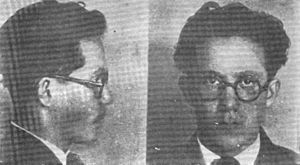
In 1935, Tito went to Moscow as a full-time official of the Comintern. He attended a big meeting in July and August 1935. He saw Joseph Stalin for the first time there. Tito was appointed to lead the Balkan section. He also taught about trade unions and studied military tactics.
Tito worked to change the Comintern's plan for Yugoslavia. They decided to defend Yugoslavia against Nazism and Fascism. Tito wanted the party leaders to be inside Yugoslavia. He traveled between Moscow, Paris, and Zagreb. In 1936, his father died.
In August 1936, Tito returned to Moscow. The Spanish Civil War had just started. Many communists were being arrested in the Soviet Union. Tito was sent back to Yugoslavia to recruit volunteers for the war in Spain. He helped send over 1,000 men to fight. He never went to Spain himself.
In June 1937, the previous CPY leader, Milan Gorkić, was arrested and killed in Moscow. Tito became the acting General Secretary of the CPY. He avoided being arrested himself by staying out of the Soviet Union as much as possible. He built a new, younger leadership team loyal to him. This included Edvard Kardelj, Aleksandar Ranković, and Milovan Đilas.
In March 1938, Tito returned to Yugoslavia. He spoke out against Germany's takeover of Austria. His appointment as General Secretary was officially approved in January 1939.
World War II: Leading the Resistance
Fighting the Invaders
On April 6, 1941, Axis forces, led by Nazi Germany, invaded Yugoslavia. The Kingdom of Yugoslavia's army quickly fell apart. On April 17, 1941, the government surrendered. Tito and other communist leaders decided to fight back.
On May 1, 1941, Tito called on everyone to unite against the occupation. On June 27, 1941, the Communist Party of Yugoslavia made Tito the commander-in-chief of all forces fighting for national freedom. The Comintern also told them to act immediately.
Tito stayed in Belgrade until September 16, 1941. Then he moved to areas controlled by rebels. He used special documents to leave Belgrade. He even met with a rival leader, Draža Mihailović, but they could not agree.
The Partisan Movement
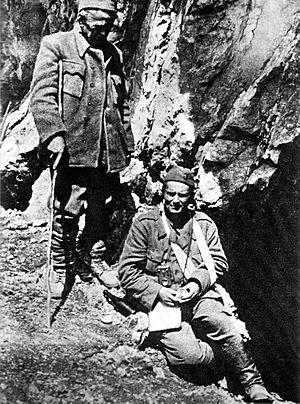
Tito's group, the Partisans, fought against the Axis forces. They also fought against other local groups. The Partisans were very successful in freeing parts of Yugoslavia. Tito ordered his forces to help Jews escape. More than 2,000 Jews fought with the Partisans.
On December 21, 1941, the Partisans created their first main fighting unit, the First Proletarian Brigade. They formed the Anti-Fascist Council of National Liberation of Yugoslavia (AVNOJ). This group planned how the country would be organized after the war. They decided Yugoslavia would be a federation of different nations. Tito was named President of this new committee.
The Axis powers tried hard to destroy the Partisans and capture Tito. On May 25, 1944, Tito managed to escape a German airborne attack on his headquarters.
Allied Support and Victory
As the Partisans grew stronger, the Allied leaders (like the US, Britain, and Soviet Union) changed their support. They switched from Mihailović to Tito. King Peter II and leaders like Franklin Roosevelt and Winston Churchill officially recognized Tito and the Partisans. This meant the Allies sent aid to the Partisans.
On June 17, 1944, Tito's government and the King's government-in-exile tried to merge. On September 12, 1944, King Peter II called on all Yugoslavs to join Tito. By then, Tito was recognized as the Prime Minister of Yugoslavia and commander-in-chief.
On September 28, 1944, Tito signed an agreement with the Soviet Union. This allowed Soviet troops to help in parts of Yugoslavia. The Partisans then launched a big attack. They broke through German lines and pushed them out of Yugoslavia. After the war, all foreign forces left Yugoslav territory.
In late 1944, the communist leaders decided to expel ethnic Germans from Yugoslavia. Their property was taken by the state. Camps were set up for this purpose. After the war, some Partisan units were involved in harsh actions against prisoners. Tito sent orders to stop these actions and send suspects to military courts.
After the War
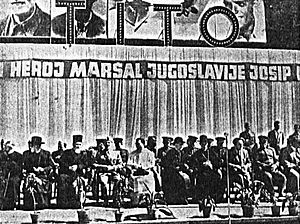
On March 7, 1945, a temporary government was formed in Belgrade. Tito was the provisional Prime Minister. This government included people from the royalist government-in-exile. In November 1945, Tito's People's Front won the elections by a lot. Many people saw Tito as the liberator of Yugoslavia.
Tito was confirmed as Prime Minister and Foreign Minister. The country was renamed the Federal People's Republic of Yugoslavia. Later, it became the Socialist Federal Republic of Yugoslavia. King Peter II was officially removed from power.
Yugoslavia built a strong army, the Yugoslav People's Army (JNA). It became the fourth strongest army in Europe. A new secret police, the State Security Administration (UDBA), was also formed. They arrested and tried many people who had worked with the Nazis. This included some Catholic clergy. Draža Mihailović was found guilty of working with the enemy and was executed.
Tito met with the head of the Catholic Church in Yugoslavia in 1945. They could not agree on the church's role. In 1946, the church leader, Aloysius Stepinac, was arrested and put on trial. The Vatican then removed Tito and the Yugoslav government from the church. But later, Yugoslavia became more religiously free than other communist countries.
In the first years after the war, Tito was seen as very loyal to Moscow. But Stalin and Tito had a difficult relationship. Stalin thought Tito was too independent.
Tito's Presidency and Global Role
Standing Up to Stalin
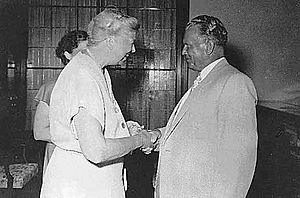
Yugoslavia was different from other countries in Eastern Europe. It had largely freed itself from Axis control with little help from the Soviet Army. This made Tito stronger in his party and with his people. He felt Yugoslavia could follow its own path.
After World War II, Yugoslavia had some conflicts with Western countries. They wanted to include Trieste in Yugoslavia, which the Western Allies did not like. Yugoslav planes even shot down U.S. aircraft. Stalin did not like these actions because he felt the Soviet Union was not ready for another war.
Tito also openly supported the communists in the Greek Civil War. Stalin was more cautious. In 1948, Tito created his own economic plan for Yugoslavia. This was different from Moscow's plan. Tito wrote that Yugoslavia was developing socialism in "somewhat different forms."
The Soviet Union criticized Tito and the Communist Party of Yugoslavia. They said Tito was too proud of his success. Tito suggested they discuss it at a meeting, but he did not go. He feared he would be attacked. In 1949, the Soviet Union and its allies planned to invade Yugoslavia. Stalin believed Tito would fall once he lost Soviet support. But Tito did not fall. On June 28, Yugoslavia was expelled from the Cominform.
This split with the Soviet Union brought Tito international recognition. But it also led to a time of trouble called the Informbiro period. Tito's type of communism was called "Titoism" by Moscow. Stalin tried to have Tito killed several times, but none of them worked.
Tito then started to crack down on people who disagreed with his government. This included people who supported the Soviet Union. Many political opponents were sent to forced labor camps, like Goli Otok. Thousands were imprisoned, and hundreds died. The camps were closed in 1956.
Because of the split, Yugoslavia received aid from the United States. But Tito did not join the Western side. After Stalin died in 1953, relations with the Soviet Union improved. Soviet leaders visited Tito in Belgrade in 1955 and apologized. Tito visited the Soviet Union in 1956.
Tito's split with the Soviet Union was very important. It was the first time a communist country successfully defied Stalin. This showed that socialism could develop in different ways.
The Non-Aligned Movement
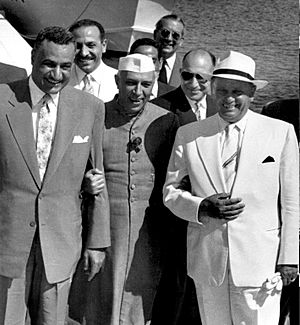
Under Tito's leadership, Yugoslavia became a founding member of the Non-Aligned Movement. In 1961, Tito helped start this movement with leaders from Egypt, India, Indonesia, and Ghana. This group of countries chose not to side with either the US or the Soviet Union during the Cold War. This greatly improved Yugoslavia's standing in the world. Tito saw it as a way to be a world leader and have more power in talks with both sides. On September 1, 1961, Josip Broz Tito became the first Secretary-General of the Non-Aligned Movement.
Tito's foreign policy led to good relationships with many governments. He visited Emperor Haile Selassie of Ethiopia. He also had a close friendship with Prince Norodom Sihanouk of Cambodia. Tito believed in countries deciding their own path. This was a key reason for his split with Stalin.
Yugoslavia had a very open travel policy. Foreigners could travel freely, and Yugoslav citizens could travel worldwide. This was rare for a communist country. Many Yugoslav citizens worked in Western Europe. Tito met many world leaders, including US presidents, British prime ministers, and other important figures.
Yugoslavia also helped anti-colonial movements in the Third World. For example, Yugoslavia was the first to bring the demands of the Algerian National Liberation Front to the United Nations. Tito supported freedom movements in African colonies. He saw the murder of Patrice Lumumba in 1961 as a terrible crime.
In 1953, Tito visited Britain and met Winston Churchill. He also visited India in 1954. After his return, he made it easier for churches and religious groups in Yugoslavia.
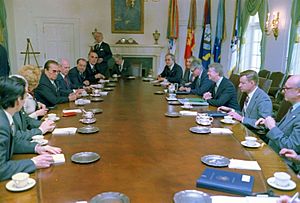
Yugoslavia's neutrality meant it had diplomatic relations with many different types of governments. For example, it was the only communist country with ties to Alfredo Stroessner's Paraguay. However, Yugoslavia did cut ties with Chile under Pinochet after Salvador Allende was overthrown.
Changes and Reforms
Starting in the 1950s, Tito allowed Yugoslav workers to go to Western Europe for jobs. This helped many Yugoslavs feel more connected to Western culture. In 1960, Tito met US President Dwight D. Eisenhower. They talked about arms control and economic growth. Tito explained that Yugoslavia's neutrality meant being active, not just passive.
On April 7, 1963, the country's official name became the Socialist Federal Republic of Yugoslavia. Reforms encouraged private businesses. Rules on religious expression were also relaxed. Tito then toured the Americas.
In 1966, an agreement with the Vatican gave more freedom to the Roman Catholic Church in Yugoslavia. Tito's new approach to socialism faced some opposition. A high-ranking official, Aleksandar Ranković, was removed from power. He was accused of spying on Tito. The power of the secret police (UDBA) was reduced. Some historians believe this shift towards a more open society played a role in Yugoslavia's later breakup.
On January 1, 1967, Yugoslavia became the first communist country to open its borders to all foreign visitors without visas. In the same year, Tito worked to find a peaceful solution to the Arab–Israeli conflict.
In 1968, Tito offered help to Czechoslovak leader Alexander Dubček against the Soviets. In 1969, Tito removed some generals because the Yugoslav army was not ready for a possible invasion.
In 1971, Tito was re-elected President for the sixth time. He introduced 20 new constitutional changes. These changes created a collective presidency with members from all republics and provinces. The goal was to give more power to the republics and provinces. The federal government would only control foreign affairs, defense, and internal security.
Tito was known for keeping Yugoslavia united. This was tested during the Croatian Spring movement. The government stopped public protests and disagreements within the Communist Party. But many of the demands from this movement were later included in the new constitution. On May 16, 1974, the new Constitution was passed. The 82-year-old Tito was named president for life. However, this constitution later caused economic problems and led to more ethnic tensions.
When Tito visited the United States, security was very tight. This was to keep him away from protesters who were unhappy with communism in Yugoslavia.
Tito's Impact and Legacy
How Tito is Remembered
Some historians say Tito had a lot of power and did not allow much disagreement. His rule was managed by a large government system. People who disagreed with the government were sometimes treated harshly. This included intellectuals and writers. Even though Yugoslavia became more liberal after 1961, the Communist Party still controlled things tightly.
Yugoslavia was able to stay independent from the Soviet Union. Its form of socialism was admired by many in Eastern Europe. But it was still a police state. Some sources say Yugoslavia had more political prisoners than all other Eastern European countries combined, outside the Soviet Union.
Tito's secret police were similar to the Soviet KGB. They were always present and sometimes acted outside the law. Yugoslavia had signed agreements to protect human rights, but some of these were not followed.
Tito's Yugoslavia respected different nationalities. But he stopped any strong nationalist movements that threatened the country's unity. Some ethnic groups were treated better than others. For example, ethnic Albanians faced severe limits on expressing their identity. Almost half of Yugoslavia's political prisoners were ethnic Albanians.
Yugoslavia grew a lot after the war. But around 1970, it started having economic problems. There was high unemployment and inflation. The country's debt grew very quickly. By 1979, with Tito getting older, the economy was expected to slow down.
Final Years and Death
After the 1974 constitutional changes, Tito started to reduce his daily involvement in running the country. He continued to travel and meet foreign leaders. He visited Beijing in 1977 and made peace with the Chinese leaders. In 1978, he traveled to the U.S. Security was very high due to protests from groups unhappy with communism.
Tito became very ill in 1979. In January 1980, he was admitted to the Medical Centre in Ljubljana. He had serious circulation problems in his legs. Tito did not want doctors to amputate his left leg. He even threatened to take his own life. After talking with his sons, he finally agreed. But the amputation was too late. Tito died on May 4, 1980, just three days before his 88th birthday.
His funeral was one of the largest in history. Leaders from 129 countries attended. This included kings, presidents, and prime ministers from both sides of the Cold War.
Tito was buried in a special mausoleum in Belgrade called the House of Flowers. Many people still visit it as a memorial. The museum there displays gifts Tito received during his presidency.
Lasting Impact
Tito is remembered for changing Yugoslavia from a poor country to a middle-income one. There were big improvements in women's rights, health, education, and industry. A 2010 poll showed that 81% of Serbs believed life was better under Tito. He was also ranked as the "Greatest Croatian" in a 2003 poll.
Many places were named after Tito during his life and after his death. Some of these names have since changed back. For example, Podgorica was once called Titograd. But some places, like the main street in Opatija, still bear his name. The largest Tito monument in the world is in Velenje, Slovenia.
Many people in former Yugoslavia still remember Tito fondly. They see him as a symbol of "better times." Every year, thousands gather in his hometown of Kumrovec to honor his memory. This is often seen as a way to remember their youth in Tito's Yugoslavia.
After Yugoslavia broke apart, some historians said that human rights were suppressed under Tito. In 2011, a court in Slovenia ruled that naming a street after Tito was unconstitutional. However, the court said this was not a judgment on Tito himself.
Family Life
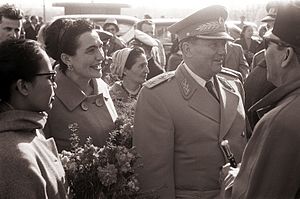
Tito was married several times. In 1919, he married Pelagija Belousova in Russia. They had five children, but only their son Žarko Leon (born 1924) survived. When Tito was in prison, Pelagija returned to Russia. They divorced in 1936.
In 1936, Tito married Lucia Bauer, an Austrian woman. Records of this marriage were later removed.
His next wife was Herta Haas, whom he married in 1940. She gave birth to their son, Aleksandar "Mišo" Broz, in May 1941. Herta and Tito separated in 1943.

His most famous wife was Jovanka Broz. They married in April 1952. Tito was almost 60, and she was 27. They did not have children together. Jovanka was present at Tito's funeral as his wife.
Tito's grandchildren include Saša Broz, a theater director, and Svetlana Broz, a cardiologist and writer. His grandson Josip Broz – Joška is a politician.
As president, Tito had access to many state-owned properties. He lived a luxurious life. His main home was the Beli dvor in Belgrade. He also had a summer residence on the Brijuni Islands. Many foreign leaders and famous people visited him there.
He also had a home at Lake Bled. He used the yacht Galeb and a special presidential airplane. He also had the Blue Train. After his death, these properties were used by the new governments.
Tito spoke several languages, including Serbo-Croatian, German, Russian, and some English. He also understood French and Italian.
In his youth, Tito was an altar boy in the Catholic Church. But after a bad experience, he never went to church again. As an adult, he identified as an atheist.
Places Named After Tito
Every federal unit in Yugoslavia had a town or city named after Tito. These places often had historical importance from World War II.
| Republic | City | Original name | ||
|---|---|---|---|---|
| Titov Drvar | Drvar | |||
| Titova Korenica | Korenica | |||
| Titov Veles | Veles | |||
| Titograda | Podgoricaa | |||
|
Titovo Užice
|
Užice
|
||
| Titovo Velenje | Velenje | |||
| athe capital of Montenegro. | ||||
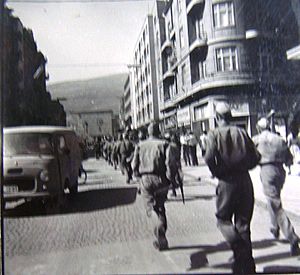
Awards and Honors
Josip Broz Tito received many awards and decorations. He got 119 awards from 60 countries. 21 of these were from Yugoslavia itself. He received the Order of the National Hero three times. He also got 98 international awards.
Some of his most famous international awards included the French Legion of Honour and the British Order of the Bath. He also received awards from the Soviet Union, Japan, Germany, and Italy.
Tito did not often wear all his awards. He usually only wore his Yugoslav ribbons. All his awards were displayed at his funeral in 1980. His reputation as a World War II leader and founder of the Non-Aligned Movement brought him much international respect.
Yugoslav Awards
| 1st Row | Order of the People's Hero | |||||
|---|---|---|---|---|---|---|
| 2nd Row | Order of the Yugoslav Great Star | Order of Freedom | Order of the Hero of Socialist Labour | Order of National Liberation | Order of the War Banner | Order of the Yugoslav Flag with Sash |
| 3rd Row | Order of the Partisan Star with Golden Wreath | Order of the Republic with Golden Wreath | Order of Merits for the People | Order of Brotherhood and Unity with Golden Wreath | Order of the People's Army with Laurel Wreath | Order of Military Merits with Great Star |
| 4th Row | Order of Bravery | Commemorative Medal of the Partisans of 1941 | 10 Years of the Yugoslav People's Army Medal | 20 Years of the Yugoslav People's Army Medal | 30 Years of the Yugoslav People's Army Medal | 30 Years of the Victory over Fascism Medal |
| Note 1: Awarded 3 times. | ||||||
| Note 2: All state decorations of the former Yugoslavia are now defunct. | ||||||
Images for kids
-
Tito's mug shot after being arrested for communist activities in 1928.
-
Tito and British prime minister Winston Churchill in 1944 in Naples, Italy.
-
Tito with North Vietnamese leader Ho Chi Minh in Belgrade, 1957.
-
Tito and Finnish president Urho Kekkonen in Helsinki, 1964.
-
Tito with Queen Elizabeth II in Belgrade, 1972.
-
"Long live Tito", graffiti in Mostar, Bosnia and Herzegovina, 2009.
See also
 In Spanish: Josip Broz Tito para niños
In Spanish: Josip Broz Tito para niños


